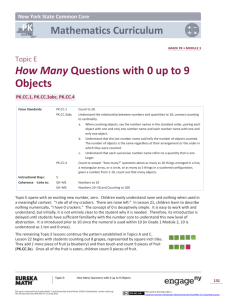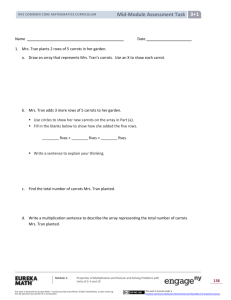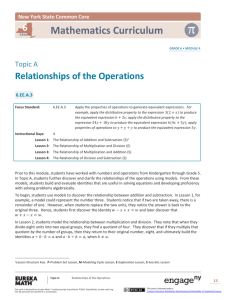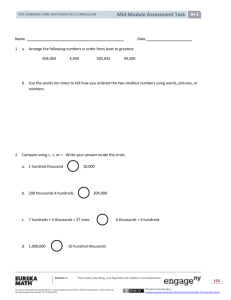G3-M4-Mid-Module Assessment
advertisement
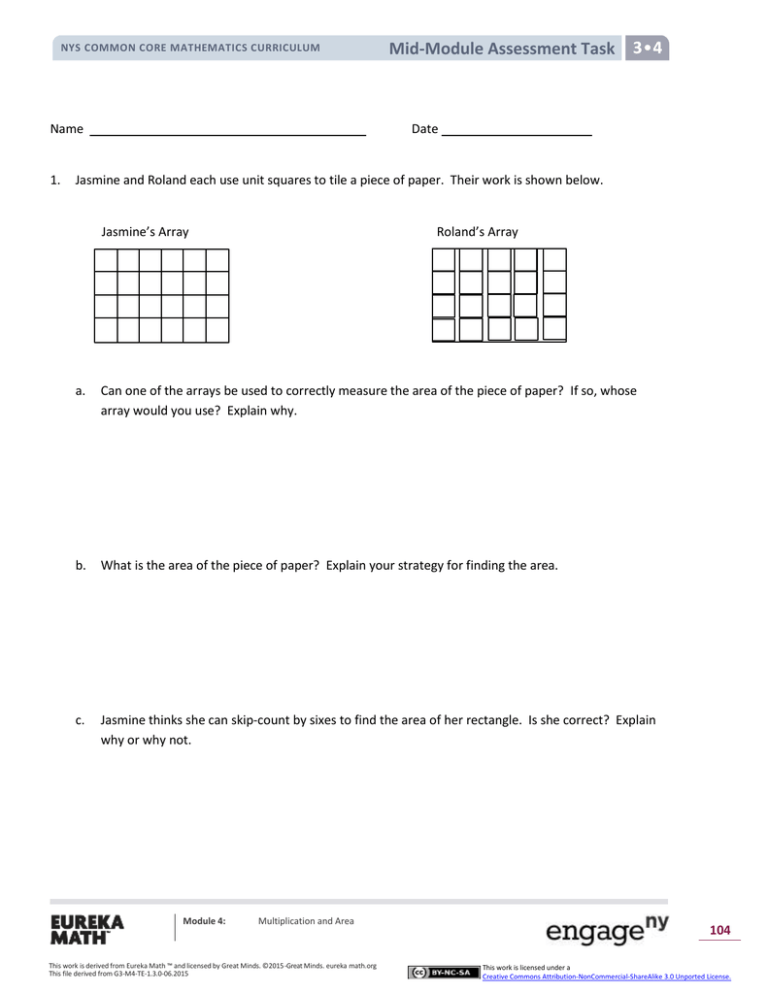
Less NYS COMMON CORE MATHEMATICS CURRICULUM Name 1. Mid-Module Assessment Task Date Jasmine and Roland each use unit squares to tile a piece of paper. Their work is shown below. Jasmine’s Array Roland’s Array a. Can one of the arrays be used to correctly measure the area of the piece of paper? If so, whose array would you use? Explain why. b. What is the area of the piece of paper? Explain your strategy for finding the area. c. Jasmine thinks she can skip-count by sixes to find the area of her rectangle. Is she correct? Explain why or why not. Module 4: Multiplication and Area This work is derived from Eureka Math ™ and licensed by Great Minds. ©2015 -Great Minds. eureka math.org This file derived from G3-M4-TE-1.3.0-06.2015 104 This work is licensed under a Creative Commons Attribution-NonCommercial-ShareAlike 3.0 Unported License. Less NYS COMMON CORE MATHEMATICS CURRICULUM Mid-Module Assessment Task 2. Jaheim says you can create three rectangles with different side lengths using 12 unit squares. Use pictures, numbers, and words to show what Jaheim is saying. 3. The area of a rectangle is 72 square units. One side has a length of 9 units. What is the other side length? Explain how you know using pictures, equations, and words. Module 4: Multiplication and Area This work is derived from Eureka Math ™ and licensed by Great Minds. ©2015 -Great Minds. eureka math.org This file derived from G3-M4-TE-1.3.0-06.2015 105 This work is licensed under a Creative Commons Attribution-NonCommercial-ShareAlike 3.0 Unported License. Less NYS COMMON CORE MATHEMATICS CURRICULUM 4. Jax started to draw a grid inside the rectangle to find its area. a. b. c. 5. Mid-Module Assessment Task Use a straight edge to complete the drawing of the grid. Write a skip-count sequence you could use to find the area. Write a multiplication equation that you could use to find the area, and then solve. Half of the rectangle below has been tiled with unit squares. a. How many more unit squares are needed to fill in the rest of the rectangle? b. What is the total area of the large rectangle? Explain how you found the area. Module 4: Multiplication and Area This work is derived from Eureka Math ™ and licensed by Great Minds. ©2015 -Great Minds. eureka math.org This file derived from G3-M4-TE-1.3.0-06.2015 106 This work is licensed under a Creative Commons Attribution-NonCommercial-ShareAlike 3.0 Unported License. Less NYS COMMON CORE MATHEMATICS CURRICULUM Mid-Module Assessment Task Mid-Module Assessment Task Standards Addressed Topics A–B Geometric measurement: understand concepts of area and relate area to multiplication and to addition. 3.MD.5 Recognize area as an attribute of plane figures and understand concepts of area measurement. a. A square with side length 1 unit, called “a unit square,” is said to have “one square unit” of area, and can be used to measure area. b. A plane figure which can be covered without gaps or overlaps by n unit squares is said to have an area of n square units. 3.MD.6 Measure areas by counting unit squares (square cm, square m, square in, square ft, and improvised units). 3.MD.7 Relate area to the operations of multiplication and addition. a. Find the area of a rectangle with whole-number side lengths by tiling it, and show that the area is the same as would be found by multiplying the side lengths. b. Multiply side lengths to find areas of rectangles with whole-number side lengths in the context of solving real world and mathematical problems, and represent wholenumber products as rectangular areas in mathematical reasoning. d. Recognize area as additive. Find areas of rectilinear figures by decomposing them into non-overlapping rectangles and adding the areas of the non-overlapping parts, applying this technique to solve real world problems. Evaluating Student Learning Outcomes A Progression Toward Mastery is provided to describe steps that illuminate the gradually increasing understandings that students develop on their way to proficiency. In this chart, this progress is presented from left (Step 1) to right (Step 4). The learning goal for students is to achieve Step 4 mastery. These steps are meant to help teachers and students identify and celebrate what the students CAN do now and what they need to work on next. Module 4: Multiplication and Area This work is derived from Eureka Math ™ and licensed by Great Minds. ©2015 -Great Minds. eureka math.org This file derived from G3-M4-TE-1.3.0-06.2015 107 This work is licensed under a Creative Commons Attribution-NonCommercial-ShareAlike 3.0 Unported License. Less NYS COMMON CORE MATHEMATICS CURRICULUM Mid-Module Assessment Task A Progression Toward Mastery Assessment Task Item and Standards Assessed 1 3.MD.5 3.MD.6 STEP 1 Little evidence of reasoning without a correct answer. STEP 2 Evidence of some reasoning without a correct answer. (1 Point) (2 Points) Response demonstrates little evidence of reasoning without a correct answer. Response shows limited reasoning with at least one correct answer. STEP 3 Evidence of some reasoning with a correct answer or evidence of solid reasoning with an incorrect answer. (3 Points) STEP 4 Evidence of solid reasoning with a correct answer. Response includes evidence of some reasoning with three correct answers or evidence of solid reasoning with an incorrect answer. Student correctly answers: (4 Points) a. Jasmine’s array, giving strong evidence of understanding that tiling must have no gaps or overlaps. b. The area is 24 square units. Student provides an appropriate explanation of the calculation (e.g., counting or skipcounting strategies). c. Yes, there are 4 rows of 6 squares, so it is possible to skipcount by six. 2 3.MD.7b Response demonstrates little evidence of reasoning without a correct answer. Module 4: Response shows limited reasoning with at least one correct answer. Multiplication and Area This work is derived from Eureka Math ™ and licensed by Great Minds. ©2015 -Great Minds. eureka math.org This file derived from G3-M4-TE-1.3.0-06.2015 Student identifies at least two of three rectangles correctly. Response includes evidence of accurate reasoning with pictures, numbers, or words. Student correctly identifies three rectangles: 1 × 12 or 12 × 1 2 × 6 or 6 × 2 3 × 4 or 4 × 3 Response shows evidence of solid reasoning using pictures, numbers, and words. 108 This work is licensed under a Creative Commons Attribution-NonCommercial-ShareAlike 3.0 Unported License. Less NYS COMMON CORE MATHEMATICS CURRICULUM Mid-Module Assessment Task A Progression Toward Mastery 3 3.MD.7b 4 3.MD.5 3.MD.6 3.MD.7a Response demonstrates little evidence of reasoning without a correct answer. Response shows limited reasoning without a correct answer. Student finds the unknown side length of 8 units but may not show enough work to clearly justify the answer. Student correctly finds the unknown side length of 8 units. Response shows evidence of solid reasoning using pictures, equations, and words. Response demonstrates little evidence of reasoning without a correct answer. Response shows evidence of some reasoning in an attempt to write a skip-counting sequence, an equation and complete the array, but work may not include a correct answer. Student accurately completes the array and finds the area of 48 sq units but may not accurately provide both a skip-count sequence and a multiplication equation. Student correctly: a. Completes the array with 8 columns and 6 rows. b. Writes one of the following skip-count sequences: 6, 12, 18, 24, 30, 36, 42, 48 OR 8, 16, 24, 32, 40, 48. c. Writes a multiplication equation (6 × 8 = 48 or 8 × 6 = 48), and gives an area of 48 sq units. 5 3.MD.5a 3.MD.5b 3.MD.7a 3.MD.7d Response demonstrates little evidence of reasoning without a correct answer to either part. Module 4: Response shows limited reasoning with a correct answer in one part. Multiplication and Area This work is derived from Eureka Math ™ and licensed by Great Minds. ©2015 -Great Minds. eureka math.org This file derived from G3-M4-TE-1.3.0-06.2015 Student slightly miscalculates the number of tiles needed to fill the remaining area, but the explanation shows evidence of solid reasoning. Part (b) is correct based on the student’s slight miscalculation but not the correct answer of 32 square units. Student correctly: a. Identifies that 16 square units are needed to fill the remaining area. b. Says the area of the large rectangle is 32 square units. Explanation gives evidence of solid reasoning to support answer. 109 This work is licensed under a Creative Commons Attribution-NonCommercial-ShareAlike 3.0 Unported License. Less NYS COMMON CORE MATHEMATICS CURRICULUM Module 4: Multiplication and Area This work is derived from Eureka Math ™ and licensed by Great Minds. ©2015 -Great Minds. eureka math.org This file derived from G3-M4-TE-1.3.0-06.2015 Mid-Module Assessment Task 110 This work is licensed under a Creative Commons Attribution-NonCommercial-ShareAlike 3.0 Unported License. Less NYS COMMON CORE MATHEMATICS CURRICULUM Module 4: Multiplication and Area This work is derived from Eureka Math ™ and licensed by Great Minds. ©2015 -Great Minds. eureka math.org This file derived from G3-M4-TE-1.3.0-06.2015 Mid-Module Assessment Task 111 This work is licensed under a Creative Commons Attribution-NonCommercial-ShareAlike 3.0 Unported License. Less NYS COMMON CORE MATHEMATICS CURRICULUM Module 4: Multiplication and Area This work is derived from Eureka Math ™ and licensed by Great Minds. ©2015 -Great Minds. eureka math.org This file derived from G3-M4-TE-1.3.0-06.2015 Mid-Module Assessment Task 112 This work is licensed under a Creative Commons Attribution-NonCommercial-ShareAlike 3.0 Unported License.




